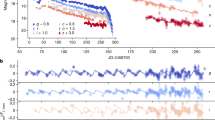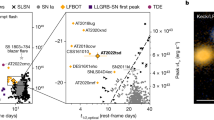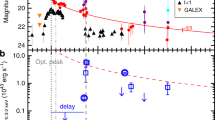Abstract
The brightest fast blue optical transients (FBOTs) are mysterious extragalactic explosions that may represent a new astrophysical phenomenon1. Their fast time to maximum brightness of less than a week, decline over several months, and atypical optical spectra and evolution are difficult to explain within the context of the core collapse of massive stars, which are powered by radioactive decay of 56Ni and evolve more slowly2,3. AT2018cow (at a redshift of 0.014) is an extreme FBOT in terms of rapid evolution and high luminosity4,5,6,7. Here we present evidence for a high-amplitude quasiperiodic oscillation of AT2018cow’s soft X-rays with a frequency of 224 Hz (at a 3.7σ significance level or false alarm probability of 0.02%) and fractional root-mean-squared amplitude of >30%. This signal is found in the average power density spectrum taken over the entire 60-day outburst and suggests a highly persistent signal that lasts for a billion cycles. The high frequency (rapid timescale) of 224 Hz (4.4 ms) argues for a compact object in AT2018cow, which could be a neutron star or black hole with a mass less than 850 solar masses. If the quasiperiodic oscillation is equivalent to the spin period of a neutron star, we can set limits on the star’s magnetic field strength. Our work highlights a new way of using high-time-resolution X-ray observations to study FBOTs.
This is a preview of subscription content, access via your institution
Access options
Access Nature and 54 other Nature Portfolio journals
Get Nature+, our best-value online-access subscription
$29.99 / 30 days
cancel any time
Subscribe to this journal
Receive 12 digital issues and online access to articles
$119.00 per year
only $9.92 per issue
Buy this article
- Purchase on Springer Link
- Instant access to full article PDF
Prices may be subject to local taxes which are calculated during checkout



Similar content being viewed by others
Data availability
All the data presented here are public and can be found in the ESA/XMM-Newton, NASA/NICER and Neil Gehrels Swift archives at: https://heasarc.gsfc.nasa.gov/cgi-bin/W3Browse/w3browse.pl. The data can be retrieved by entering the source coordinates: 16 h 16 min 00.22 s, 22° 16′ 04.91″ (J2000.0 epoch). Any additional data are available from the corresponding author. Source data are provided with this paper.
Code availability
Python codes to download the data from HEASARC public archive, reduce it and reproduce the results in this paper are available at: https://github.com/pdheerajreddy/at2018cowQPO.git.
References
Inserra, C. Observational properties of extreme supernovae. Nat. Astron. 3, 697–705 (2019).
Drout, M. R. et al. Rapidly evolving and luminous transients from Pan-STARRS1. Astrophys. J. 794, 23 (2014).
Pursiainen, M. et al. Rapidly evolving transients in the Dark Energy Survey. Mon. Not. R. Astron. Soc. 481, 894–917 (2018).
Rivera Sandoval, L. E. et al. X-ray Swift observations of SN 2018cow. Mon. Not. R. Astron. Soc. 480, L146–L150 (2018).
Margutti, R. et al. An embedded x-ray source shines through the aspherical AT 2018cow: revealing the inner workings of the most luminous fast-evolving optical transients. Astrophys. J. 872, 18 (2019).
Prentice, S. J. et al. The Cow: discovery of a luminous, hot, and rapidly evolving transient. Astrophys. J. Lett. 865, L3 (2018).
Perley, D. A. et al. The fast, luminous ultraviolet transient AT2018cow: extreme supernova, or disruption of a star by an intermediate-mass black hole? Mon. Not. R. Astron. Soc. 484, 103–1049 (2019).
Tanaka, M. et al. Rapidly rising transients from the Subaru Hyper Suprime-Cam transient survey. Astrophys. J. 819, 5 (2016).
Rest, A. et al. A fast-evolving luminous transient discovered by K2/Kepler. Nat. Astron. 2, 307–311 (2018).
Ho, A. Y. Q. et al. The photometric and spectroscopic evolution of rapidly evolving extragalactic transients in ZTF. Preprint at https://arxiv.org/abs/2105.08811 (2021).
Perley, D. A. et al. Real-time discovery of AT2020xnd: A fast, luminous ultraviolet transient with minimal radioactive ejecta. Mon. Not. R. Astron. Soc. 508, 5138–5147 (2021).
Coppejans, D. L. et al. A mildly relativistic outflow from the energetic, fast-rising blue optical transient CSS161010 in a dwarf galaxy. Astrophys. J. Lett. 895, L23 (2020).
Ho, A. Y. Q. et al. The Koala: a fast blue optical transient with luminous radio emission from a starburst dwarf galaxy at z = 0.27. Astrophys. J. 895, 49 (2020).
Leung, S.-C. et al. A model for the fast blue optical transient AT2018cow: circumstellar interaction of a pulsational pair-instability supernova. Astrophys. J. 903, 66 (2020).
Fox, O. D. & Smith, N. Signatures of circumstellar interaction in the unusual transient AT 2018cow. Mon. Not. R. Astron. Soc. 488, 3772–3782 (2019).
Kasen, D. & Bildsten, L. Supernova light curves powered by young magnetars. Astrophys. J. 717, 245 (2010).
Metzger, B. D. & Piro, A. L. Optical and X-ray emission from stable millisecond magnetars formed from the merger of binary neutron stars. Mon. Not. R. Astron. Soc. 439, 3916–3930 (2014).
Lyutikov, M. & Toonen, S. Fast-rising blue optical transients and AT2018cow following electron-capture collapse of merged white dwarfs. Mon. Not. R. Astron. Soc. 487, 5618–5629 (2019).
Kuin, N. P. M. et al. Swift spectra of AT2018cow: a white dwarf tidal disruption event? Mon. Not. R. Astron. Soc. 487, 2505–2521 (2019).
Tanaka, M. et al. Rapidly rising transients from the Subaru Hyper Suprime-Cam Transient Survey. Astrophys. J. 819, 5 (2016).
Tonry, J. L. et al. ATLAS: a high-cadence All-sky Survey System. Publ. Astron. Soc. Pac. 130, 064505 (2018).
Smartt, S. J. et al. ATLAS18qqn (AT2018cow)—a bright transient spatially coincident with CGCG 137-068 (60 Mpc). The Astronomer’s Telegram 11727 (2018).
Ho, A. Y. Q. et al. AT2018cow: a luminous millimeter transient. Astrophys. J. 871, 73 (2019).
Huang, K. et al. ALMA polarimetry of AT2018cow. Astrophys. J. Lett. 878, L25 (2019).
Quataert, E. & Kasen, D. Swift 1644+57: the longest gamma-ray burst? Mon. Not. R. Astron. Soc. 419, L1–L5 (2012).
Mohan, P., An, T. & Yang, J. The nearby luminous transient AT2018cow: a magnetar formed in a subrelativistically expanding nonjetted explosion. Astrophys. J. Lett. 888, L24 (2020).
McClintock, J. E. & Remillard, R. A. Black Hole Binaries 157–213 (Cambridge Univ. Press, 2006).
Alston, W. N. et al. Discovery of an ~2-h high-frequency X-ray QPO and iron Kα reverberation in the active galaxy MS 2254.9-3712. Mon. Not. R. Astron. Soc. 449, 467–476 (2015).
Ashton, D. I. & Middleton, M. J. Searching for energy-resolved quasi-periodic oscillations in AGN. Mon. Not. R. Astron. Soc. 501, 5478–5499 (2021).
Gierliński, M., Middleton, M., Ward, M. & Done, C. A periodicity of ~1 hour in X-ray emission from the active galaxy RE J1034+396. Nature 455, 369–371 (2008).
Pasham, D. R. et al. A loud quasi-periodic oscillation after a star is disrupted by a massive black hole. Science 363, 531–534 (2019).
Reis, R. C. et al. A 200-second quasi-periodicity after the tidal disruption of a star by a dormant black hole. Science 337, 949–951 (2012).
Lin, D., Irwin, J. A., Godet, O., Webb, N. A. & Barret, D. A ~3.8 hr periodicity from an ultrasoft active galactic nucleus candidate. Astrophys. J. Lett. 776, L10 (2013).
Ribeiro, E. M., Méndez, M., de Avellar, M. G. B., Zhang, G. & Karpouzas, K. The amplitude of the kilohertz quasi-periodic oscillations in 4U 1636-53 in the frequency-energy space. Mon. Not. R. Astron. Soc. 489, 4980–4991 (2019).
Watts, A. L. & Strohmayer, T. E. Neutron star oscillations and QPOs during magnetar flares. Adv. Space Res. 40, 1446–1452 (2007).
Kremer, K. et al. Fast optical transients from stellar-mass black hole tidal disruption events in young star clusters. Astrophys. J. 911, 104 (2021).
Frohmaier, C. et al. From core collapse to superluminous: the rates of massive stellar explosions from the Palomar Transient Factory. Mon. Not. R. Astron. Soc. 500, 5142–5158 (2021).
Taylor, M. et al. The core collapse supernova rate from the SDSS-II Supernova Survey. Astrophys. J. 792, 135 (2014).
Gendreau, K. C. et al. The Neutron star Interior Composition Explorer (NICER): design and development. Proc. SPIE 9905, 99051H (2016).
Gehrels, N. et al. The Swift gamma-ray burst mission. Astrophys. J. 611, 1005 (2004).
Burrows, D. N. et al. The Swift X-ray telescope. Space Sci. Rev. 120, 165–195 (2005).
Jansen, F. et al. XMM-Newton observatory. I. The spacecraft and operations. Astron. Astrophys. 365, L1–L6 (2001).
Strüder, L. et al. The European Photon Imaging Camera on XMM-Newton: The pn-CCD camera. Astron. Astrophys. 365, L18–L26 (2001).
Prigozhin, G. et al. Proc. SPIE 8543, 854318 (2012).
Remillard, R. A. et al. An empirical background model for the NICER X-ray timing instrument. Preprint at https://arxiv.org/abs/2105.09901 (2021).
Kaastra, J. S. & Bleeker, J. A. M. Optimal binning of X-ray spectra and response matrix design. Astron. Astrophys. 587, A151 (2016).
van der Klis, M. Timing Neutron Stars 27–70 (Springer, 1988).
Vaughan, S., Edelson, R., Warwick, R. S. & Uttley, P. On characterizing the variability properties of X-ray light curves from active galaxies. Mon. Not. R. Astron. Soc. 345, 1271–1284 (2003).
Shapiro, S. L. & Teukolsky, S. A. Black Holes, White Dwarfs, and Neutron Stars: The Physics of Compact Objects (Wiley, 1983).
Metzger, B. D., Beniamini, P. & Giannios, D. Effects of fallback accretion on protomagnetar outflows in gamma-ray bursts and superluminous supernovae. Astrophys. J. 857, 95 (2018).
Shvartsman, V. F. Neutron stars in binary systems should not be pulsars. Soviet Ast. 15, 342 (1971).
Illarionov, A. F. & Sunyaev, R. A. Why the number of galactic x-ray stars is so small? Astron. Astrophys. 39, 185 (1975).
Lipunov, V. M. Astrophysics of Neutron Stars (Springer, 1992).
Davidson, K. & Ostriker, J. P. Neutron-star accretion in a stellar wind: model for a pulsed x-ray source. Astrophys. J. 179, 585 (1973).
Piro, A. L. & Ott, C. D. Supernova fallback onto magnetars and propeller-powered supernovae. Astrophys. J. 736, 108 (2011).
Parfrey, K., Spitkovsky, A. & Beloborodov, A. M. Torque enhancement, spin equilibrium, and jet power from disk-induced opening of pulsar magnetic fields. Astrophys. J. 822, 33 (2016).
Alpar, M. A. On young neutron stars as propellers and accretors with conventional magnetic fields. Astrophys. J. 554, 1245 (2001).
Ransom, S. M., Eikenberry, S. S. & Middleditch, J. Fourier techniques for very long astrophysical time-series analysis. Astron. J. 124, 1788 (2002).
Andersen, B. C. & Ransom, S. M. A Fourier domain ‘jerk’ search for binary pulsars. Astrophys. J. Lett. 863, L13 (2018).
Bagchi, M., Lorimer, D. R. & Wolfe, S. On the detectability of eccentric binary pulsars. Mon. Not. R. Astron. Soc. 432, 1303–1314 (2013).
Chen, J.-H. & Shen, R.-F. Tidal disruption of a main-sequence star by an intermediate-mass black hole: a bright decade. Astrophys. J. 867, 20 (2018).
Dexter, J. & Kasen, D. Supernova light curves powered by fallback accretion. Astrophys. J. 772, 30 (2013).
Quataert, E., Lecoanet, D. & Coughlin, E. R. Black hole accretion discs and luminous transients in failed supernovae from non-rotating supergiants. Mon. Not. R. Astron. Soc. 485, L83–L88 (2019).
Acknowledgements
This work is based on observations made with NICER, XMM-Newton and Swift. D.R.P was partly supported by NASA grant number 80NSSC21K0102. D.R.P thanks S. van Velzen for bringing AT2018cow to his attention and D. Buisson for testing the Python code. D.R.P would also like to thank G. Prigozhin for deep discussions relating to NICER noise sources.
Author information
Authors and Affiliations
Contributions
D.R.P. led the overall project and wrote the majority of the paper. W.C.G.H. and B.D.M. helped with the theoretical implications of a newborn neutron star. They also wrote part of the paper. W.A. provided an independent verification of the statistical significance of the QPO. R.R., D.A., D.C., A.F., P.B., F.T., J.H., M.N., J.F.S., T.S., E.M.C. and A.H. facilitated the discussion and contributed to the interpretation of the results. J.M. proposed the NICER observations. K.G. and Z.A. carried out the observations.
Corresponding author
Ethics declarations
Competing interests
The authors declare no competing interests.
Additional information
Peer review information Nature Astronomy thanks Adam Ingram and the other, anonymous, reviewer(s) for their contribution to the peer review of this work.
Publisher’s note Springer Nature remains neutral with regard to jurisdictional claims in published maps and institutional affiliations.
Extended data
Extended Data Fig. 1 Average energy spectra of AT2018cow and the background.
The red and the black histograms show the source and the background spectra, respectively. The errorbars represent the 1σ uncertainties. Beyond 2.5 keV (dashed vertical line) the ratio of source to background counts (signal-to-noise) drops below 2. Because the sensitivity towards detecting a QPO depends on source2/(source+background)47, we chose to omit events above 2.5 keV.
Extended Data Fig. 2 Probability plot to visually assess whether the power values in the PDS continuum are χ2 distributed.
This is a qualitative assessment tool that tells us that if the data points lie on a straight line, as they do, they appear consistent with the theorized model, which in the present case is a χ2 distribution with 2 × 105 × 2048 degrees of freedom (see section Probability plot: a qualitative assessment of noise for more details).
Extended Data Fig. 3 White noise tests for soft X-ray PDS of AT2018cow.
(a): Comparing the empirical distribution function (EDF) of the values in the PDS continuum (blue histogram) with the cumulative distribution function of a χ2 distribution with 2 × 105 × 2048 degrees of freedom. (b): Comparison of the observed probability distribution function (PDF) with the expected PDF of a χ2 distribution with 2 × 105 × 2048 dof. (c): The distribution of the K-S statistic derived from EDFs sampled from a χ2 distribution with 2 × 105 × 2048 dof. (d): Same as (c) but using an Anderson-Darling test statistic. Both the test statistic values are consistent with a χ2 distribution and suggest that the PDS continuum is white (see section PDS continuum is consistent with White noise for more details).
Extended Data Fig. 4 XMM-Newton/EPIC-pn soft X-ray (0.25-2.5 keV) PDS of AT2018cow to assess noise continuum at low frequencies.
The PDS was derived by averaging 15 1024 s light curve segments sampled at 1/16 Hz. The frequency resolution is 1/2048 Hz. The error bars represent the 1-σ uncertainties. The red horizontal line is the Poisson noise level of 2. The 224 Hz QPO in NICER data is outside of this band pass, that is, beyond EPIC-pn’s Nyquist frequency.
Extended Data Fig. 5 The probability density function (PDF) (left) and the cumulative distribution function (CDF) (right) of the 105 simulated maximum Δχ2 values.
The vertical dashed red line marks the value of the Δχ2 of the observed 224 Hz QPO. The false alarm probability (1-CDF) vs Δχ2 is shown in the right panel of Fig. 1. The false alarm probability of seeing a spurious signal as strong as the one seen in data at 224 Hz is 0.0002 (1 in 5000).
Extended Data Fig. 6 NICER PDS of various types of noise.
They both track the particle background. (c) The average PDS of 0.0-0.2 keV events. These are the optical light leak events. (d) The average PDS derived from trumpet-rejected events. These are the off-axis events that track the cosmic X-ray and other sources in the FoV. In all cases, the frequency resolution, the number of spectra averaged and the frequency rebinning is same as the left panel of Fig. 1. The red shaded rectangle shows the location of the 224 Hz QPO. The dashed horizontal line indicates the expected Poisson noise level of 2. All the errorbars represent the 1-σ uncertainties.
Extended Data Fig. 7 NICER power spectra with one MPU removed at a time.
The QPO properties, that is, fractional rms strength, centroid and width are all same (within error bars) across all the above PDS. The error bars in each panel represent 1-σ uncertainties.
Extended Data Fig. 8 AT2018cow’s average X-ray power density spectrum with plausible GPS noise events removed.
This PDS is indistinguishable from Fig. 1 (see section The signal is not due to ‘GPS’ noise for more details).
Extended Data Fig. 9 QPO’s signal-to-noise ratio and signal-to-noise over average count rate vs accumulated exposure time.
The signal-to-noise ratio and the signal-to-noise ratio normalized by average count rate are shown by blue diamonds and red crosses, respectively. The data points are not independent (see sec. 2.4 for more details). See also Supplementary Video 1. Data available in supplementary files.
Extended Data Fig. 10 Average PDS of 3 AGN monitored by NICER during the same 2 month period as AT2018cow.
The AGN names are shown on each panel. The mean count rates (exposures) (from top to bottom) are 30.5 (15.6 ks), 3.9 (14.3 ks) and 1.2 (33.3 ks) counts/s, respectively. These PDS were extracted exactly the same way as the average PDS of AT2018cow in Fig. 1. The location of AT2018cow’s QPO is indicated by the red shaded area. The errorbars represent the 1-σ uncertainties.
Supplementary information
Supplementary Information
Supplementary Fig. 1 and Table 1.
Supplementary Video 1
The top panel of the movie shows the evolution of the average PDS and the gradual improvement in the QPO signal at 224 Hz with accumulated exposure. The lower panel shows the corresponding long-term light curve. The shaded red rectangle in the top panel shows the location of the 224 Hz QPO. This suggests that the QPO is long-lived and present in the majority of the observations.
Source data
Source Data Fig. 1
Numerical data giving frequency (HzHz), power and the error on the power.
Rights and permissions
About this article
Cite this article
Pasham, D.R., Ho, W.C.G., Alston, W. et al. Evidence for a compact object in the aftermath of the extragalactic transient AT2018cow. Nat Astron 6, 249–258 (2022). https://doi.org/10.1038/s41550-021-01524-8
Received:
Accepted:
Published:
Issue Date:
DOI: https://doi.org/10.1038/s41550-021-01524-8



